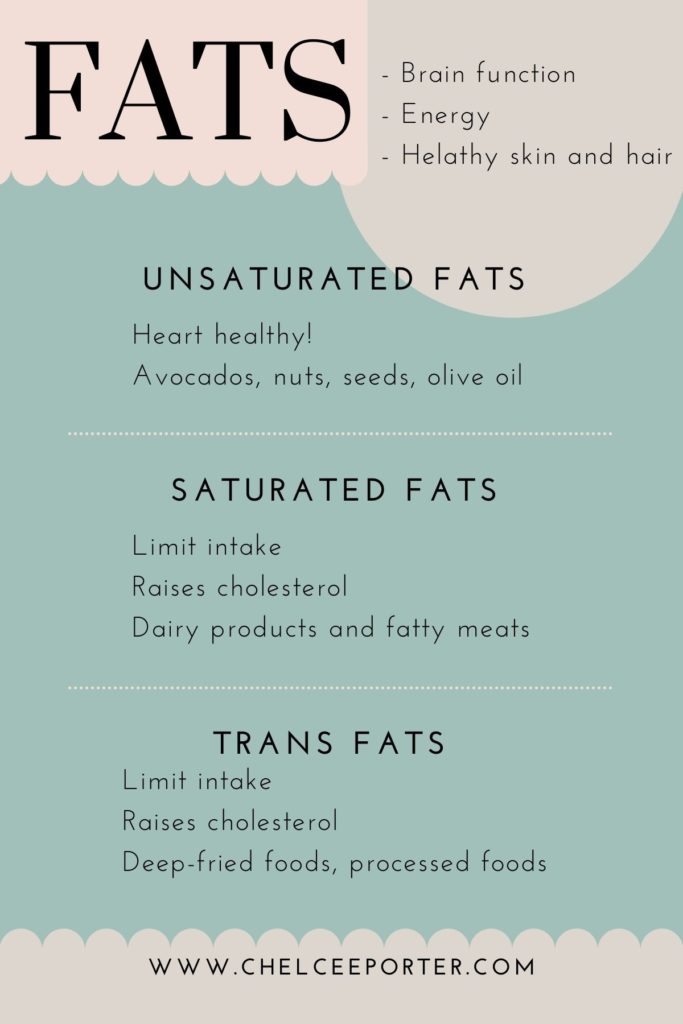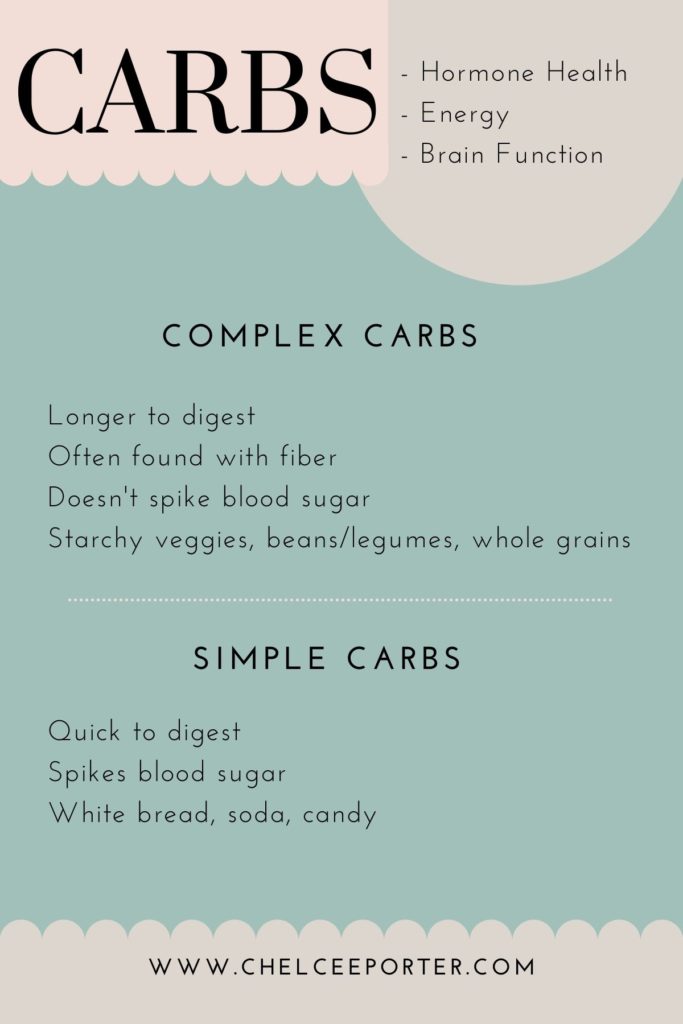I’m sure you’ve heard of macronutrients before. A lot of people these days “count their macros” as a way of dieting. I think there are some benefits of doing this but I don’t think it should be a be-all-end-all when thinking about food. Like I’ve told you before, food is more than just a number and it can be easy to slip into a vicious cycle of counting and tracking every little thing you eat. However, knowing what your food contains and how it is helping nourish your body can be very beneficial. I always find it more fun (and easier) to eat healthier options when I know exactly what each food is doing to help my body.
On all packaged foods you can find the macronutrients on the nutrition label. Check out my previous post on how to read a nutrition label to see exactly where to find them. Now, let’s take a closer look at what each of the macronutrients is.

Fats
Fats help play many important roles in our bodies. They are used for energy, keeping our skin looking youthful, and helping with brain function. Vitamins K, A, D, and E need fats to help be absorbed by our body. Fats are made up of fatty acids which play an important role in influencing cholesterol. Fats are broken down into different subtypes.
Unsaturated Fats (polyunsaturated and monounsaturated)
Unsaturated fats help decrease the risk of cardiovascular disease. They help lower LDL (or bad) cholesterol and help raise HDL (or good) cholesterol. Omega 3s and Omega 6s are included in this subtype. You can find unsaturated fats in avocados, nuts, seeds, olives, and fish. By including a variety of these foods in our diet, we can help our heart health, hormone health, and brain function. Win!
Fun Fact: The American Heart Association and American College of Cardiology include the Mediterranean diet as a recommended diet for heart health.1 This diet includes lots of fresh veggies and fruit, fish, olive oil, and whole grains. (Pretty much the foods you think of when you think of Mediterranean food.)
Saturated Fats
Saturated fats on the other hand do the opposite. They help to raise LDL (or bad) cholesterol and decrease HDL (or good) cholesterol. Unfortunately, this leads to a higher risk of dyslipidemia (high cholesterol), heart attack, and stroke. You can find saturated fats in dairy products and fatty meats. By reducing the intake of these fats in our diets, we can greatly improve our cardiovascular outcomes.
Trans Fats
Trans fats are most often made by chemically altering fat molecules to be more stable at room temperature. Food companies use these in their products to increase their shelf life. Not good! It is common to see trans fats used to deep fry things too. Like saturated fats, they raise LDL cholesterol and decrease HDL cholesterol. The easiest way to identify trans fats is to look at the nutrition label. They are often labeled as “partially hydrogenated oil” in the ingredient section. Above all, we definitely want to avoid these as much as we can.

Carbohydrates
Carbohydrates get a very bad rep but I am here to tell you that they are an essential part of a healthy, balanced diet. Women need carbs (along with fats and protein) for hormone health and brain function. Carbohydrates are broken down into glucose which is then moved into your cells by our friend insulin to be used for energy. Without energy, our bodies can’t perform optimally.
Simple vs Complex Carbs
You can break carbohydrates down into simple and complex carbs. Simple carbs have a smaller chemical structure and are quickly processed by the body. This can lead to spikes in our blood sugar if consuming too much at once. Examples of simple carbs include processed foods like white bread, soda, and candy.
On the other hand, complex carbs contain fiber and starch which takes the body longer to process. This leads to a gradual rise in blood sugar which is much easier for the body to control. The added fiber helps keep you fuller for longer too. Examples of complex carbs include whole grains, starchy veggies like potatoes and squash, and beans/legumes.

Protein
Amino acids are the building blocks of protein. Our bodies use many different amino acids to perform various functions every day. Amino acids are involved in making proteins, hormones, and neurotransmitters (the little chemicals in our nervous system that tell our body what to do). They are used for energy, metabolism, and immune function just to name a few.
Essential Vs. Non-Essential
There are 20 amino acids that our bodies use, 9 of which are essential. Essential amino acids are those that our body can not make on its own. We have to consume them in our diet for our body to have them. Don’t worry about get bogged down by which ones are essential and non-essential. If you are including a good amount of protein from various sources in your diet you don’t need to worry. Each food source has slightly different amino acid profiles.
Fun fact: The amino acid tryptophan is a precursor to serotonin. Serotonin sometimes referred to as the “happy hormone” is involved in helping us feel relaxed and happy. Tryptophan is found in turkey which is why you can get tired and sleepy after eating it!
As you can see, protein is a very important component of a healthy, balanced diet. You can find protein in meats, fish, eggs, beans, nuts, seeds, and many other things. The amount of protein needed varies from person to person.

If you are interested in learning more about how many macronutrients your body needs, I recommend speaking with your healthcare provider or dietician to ensure an individualized approach. Like I always say, what works for someone else might not be what’s best for your body!
Overall, each macronutrient plays an important role in allowing our body to function optimally. Each of us thrives off of different amounts of each one but everyone needs all three nutrients! Don’t let yourself get sucked into low-carb, low-fat, and all those other strict diets. A sustainable diet includes all macronutrients! What questions do you have about macronutrients? Let me know in the comments below!





